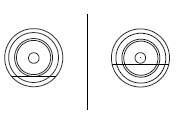Driving through water
If driving through deep or standing water is unavoidable, proceed very slowly. Never drive through water that is higher than the bottom of the wheel rims (for cars) or the bottom of the hubs (for trucks).

When driving through water, traction or brake capability may be limited.
Also, water may enter your engine’s air intake and severely damage your engine or your vehicle may stall. Driving through deep water where the transmission vent tube is submerged may allow water into the transmission and cause internal transmission damage.
Once through the water, always dry the brakes by moving your vehicle slowly while applying light pressure on the brake pedal.
Wet brakes do not stop the vehicle as quickly as dry brakes.
See also:
Instrument Cluster
Gauges
Type 1
Cluster shown in standard measure – metric clusters similar.
A. Tachometer
B. Information display. See Information displays for more information.
C. Speedometer
D. Fuel gauge
...
Vehicle Health Report
WARNING: Always follow scheduled maintenance instructions, regularly inspect
your vehicle, and seek repair for any damage or problem you suspect. Vehicle Health
Report supplements, but cannot repl ...
Power steering fluid check
Check the power steering fluid. Refer to scheduled maintenance information.
1. Start the engine and let it run until it reaches normal operating temperature
(the engine coolant temperature gauge in ...
